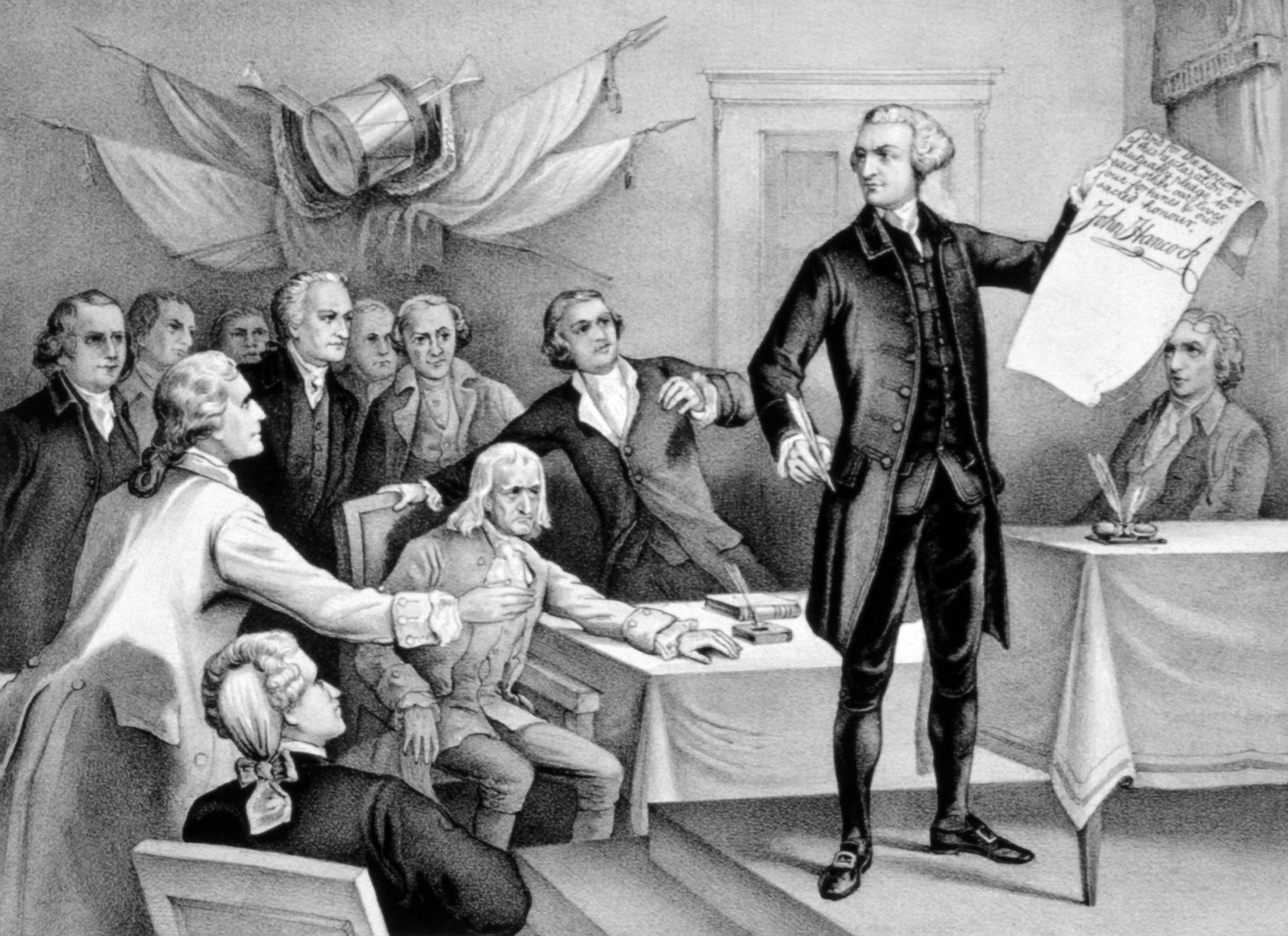Impress your fellow Americans with the patriotic etymologies of these July 4 words
From a spangle to a donzerly


It's Independence Day, and it's time to raise Old Glory high, spend a few greenbacks on fireworks, and sing "The Star-Spangled Banner"! While you're doing that, pause for a moment and reflect on a great seldom-asked question: What is the definition of spangle?
We all sing it. We all know it in the phrase "star-spangled banner." But it wasn't invented for that phrase. It's one of a few odd words and phrases connected with America and the Fourth of July that we may use without thinking twice about ... until now.
1. Spangle
The Week
Escape your echo chamber. Get the facts behind the news, plus analysis from multiple perspectives.

Sign up for The Week's Free Newsletters
From our morning news briefing to a weekly Good News Newsletter, get the best of The Week delivered directly to your inbox.
From our morning news briefing to a weekly Good News Newsletter, get the best of The Week delivered directly to your inbox.
A spangle is a sparkly thing that dangles: a geometric piece of shiny metal or plastic ornamentation. Or, by figurative use, anything that looks like one. It's pretty much the same as a sequin, although costume historians argue about the difference. Spangle is also a verb meaning "adorn with spangles" or "glitter as if spangled." It comes from a Middle English word, spang, meaning "shiny ornament." It probably came from a Scandinavian language. English has had it for about twice as long as the United States has been independent. But we don't talk about spangles as much today — if Francis Scott Key had written his poem a century and a half later, we might be singing about "the star-sequined banner."
2. Bunting
When you run up the grand old flag, you may also put out bunting — festive decorations such as drapery and fan-folded fabric in the red, white, and blue. Did you know the flag itself is also bunting? The word originally refers to the kind of sturdy material that flags and festive draperies are made out of (when they're not made out of paper). From that it came to be used for the decorations. The origins of the word are a bit unclear, but it's not related to the kind of bunting a baseball player does, though that's pretty American too.
3. Score
A free daily email with the biggest news stories of the day – and the best features from TheWeek.com
You know the word score, of course, as in the score of a baseball game, or the score of a musical work (for instance the sheet music to "The Star-Spangled Banner"). But Abraham Lincoln wasn't talking about either of those when he said "Four score and seven years ago…" He was speaking at Gettysburg, 87 years after the new nation of the U.S.A. was brought forth. So the math is simple: A score is 20. But we pretty much never use it to mean that anymore, except when quoting Honest Abe. The next question is why we ever did … and the answer comes from tally sticks. Centuries ago, it was common to keep track of large quantities by notching a stick for every 20 that were counted (this also relates to why some languages, such as French and Gaelic, have number systems that partially go by 20s). That is the source of score meaning 20 — and also of score meaning "scratch or notch a mark in" and score meaning "total tally" and, in fact, by various sense developments, every other meaning of score. It all started with Old Norse skor, which referred to those notches and the 20s they counted.
4. Yankee
Speaking of musical scores, there's "Yankee Doodle," a song first made to mock American colonists but quickly picked up by them and sung proudly. If you ask anyone in another country what a Yankee is, they'll say "an American." But if you ask Southerners whether they're Yankees, you might hear otherwise! To a Southerner, a Yankee is a Northerner. But not all Northerners would say they're Yankees either — many will tell you a Yankee is someone from the Northeast. Fair enough: That's where the term started. You may hear various stories about American Indian origins of Yankee, but they all rely on some amount of invention. Most likely, the word actually comes from the Dutch settlers from around New Amsterdam (now New York), up the Hudson River, and in nearby colonies. The name Janke, said with a J like "y," is Dutch for Johnnie. The earliest uses of Yankee — more often spelled Yanky — are generic references, sort of like "G.I. Joe" is, only these were Dutch settlers, not U.S. Army soldiers.
5. Dixie
So we know that Yankees aren't from Dixie. But where is Dixie? Not everyone uses Dixie to mean exactly the same area. Are Oklahoma and Missouri part of Dixie? Some say yes, some say no. Are Texas and Virginia? More say yes, but not everyone. But everything from Louisiana and Arkansas through to South Carolina sure is (well, some disagree about Florida). Now, how about where the word Dixie came from? Not everyone agrees on that, either! It could be named after Jeremiah Dixon, one of the surveyors who drew the Mason-Dixon line between Maryland and Pennsylvania, which was an important border between the Northern and Southern states (even though Maryland isn't considered part of Dixie now), but it could also be named after $10 notes commonly used as currency in Louisiana, bearing the French "Dix" on them and, so it is said, giving the area around New Orleans the name Dixieland, which spread from there. We can't use "Dixieland jazz" to verify that, though — that dates to the early 1900s, while the Southern anthem "Dixie" was written in 1859.
6. E pluribus unum, annuit cœptis, novus ordo seclorum
Americans of today don't look at their money and see French words. But it's not all English, either. "In God we trust," sure, and — as the rejoinder goes — all the rest pay cash. But look at the two sides of the Great Seal that flank that English motto on the $1 bill: ANNUIT CŒPTIS, NOVUS ORDO SECLORUM, and E PLURIBUS UNUM. Of those three, E pluribus unum is the best known, because it's on a banner clutched by the American eagle. You probably know what it means, too: "Out of many, one." How about the other two, though? Annuit cœptis means "He approves (or has approved) the undertakings (or beginnings)." Remember that that œ is treated like an e. Who is "He"? God, of course. And Novus ordo seclorum means "A new order of the ages" — seclorum, "of the ages," is an alternative form of a word you may hear in Latin prayers: "et in sæcula sæculorum, Amen." Novus ordo seclorum is a loose borrowing from a poem by the Roman poet Virgil that was seen by Medieval Christians as a prophecy of the coming of Christ. Who put those phrases on the Great Seal? Charles Thomson, a former Latin teacher, who designed it in 1782. An earlier version commissioned by Samuel Adams and designed by William Barton had different Latin: Deo favente, "With God favoring," and Perennis, "Everlasting." Do you suppose those would have been more widely used than what replaced them?
7. John Hancock and John Henry
If you look at the bottom of the front of a dollar bill, you'll see a couple of John Hancocks. I don't mean literally guys named John Hancock; I just mean signatures — in this case of the treasurer of the United States and the secretary of the treasury. If, on the other hand, you look at the Declaration of Independence, you will see the name John Hancock in large, beautiful handwriting. John Hancock was one of the richest men in the colonies, a strong supporter of independence and a political protégé of Samuel Adams, and he signed his name large on the Declaration — so that, as the story goes, King George could read it. That story may have been a later invention, but so was something else: a cowboy habit of saying "your John Henry" instead of "your John Hancock" to mean your signature. That doesn't seem to refer to the folk-hero railroad-worker called John Henry, because it dates to before he became a famous folk hero (and because he wasn't known for writing his name). We can speculate as to why the cowboys might have preferred Henry to Hancock, but we don't know for sure.
8. Donzerly
There's one last word that we can't overlook — even though it's not a real word. Or is it? When you sing the national anthem, you start "O say, can you see by the dawn's early light" — but many a young child has misheard "dawn's early light" as "donzerly light." It belongs to the same set of misheard invented words as "mairzy doats." It's become an occasional light-hearted reference to the anthem now. But… it's not a real word, right? Well, you tell me: If I said "the room was suffused with donzerly light," could you say what you expected to see? I bet it would be a flag … and suitably epic, patriotic lighting for it.
James Harbeck is a professional word taster and sentence sommelier (an editor trained in linguistics). He is the author of the blog Sesquiotica and the book Songs of Love and Grammar.
-
 Heavenly spectacle in the wilds of Canada
Heavenly spectacle in the wilds of CanadaThe Week Recommends ‘Mind-bending’ outpost for spotting animals – and the northern lights
-
 Facial recognition: a revolution in policing
Facial recognition: a revolution in policingTalking Point All 43 police forces in England and Wales are set to be granted access, with those against calling for increasing safeguards on the technology
-
 Codeword: December 14, 2025
Codeword: December 14, 2025The daily codeword puzzle from The Week
